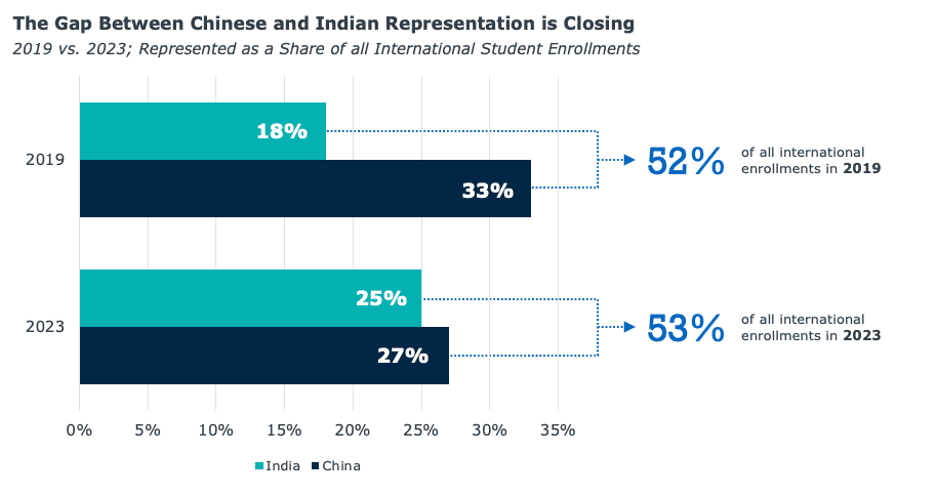The current state of international enrollment
When the pandemic hit and international enrollment plunged, I experienced it firsthand.
Prior to joining EAB, I spent more than a decade spearheading international admissions at the University of La Verne. Like most enrollment leaders, I wondered how many years it would take for international student interest to bounce back.
But now, just three years later, overall international student enrollment is making an incredible comeback with the largest year-over-year increase in more than 40 years.
We know this because the Institute for International Education (IIE) produces the annual Open Doors Report on International Educational Exchange. In 2023, they surveyed more than 3,000 colleges and universities–67 percent of U.S. institutions–with representation from every state and territory. After assessing this year’s data, my team at EAB has identified three key takeaways to help you tap into this incredible growth.
International enrollment is on the rise
In Fall 2023, 1,057,888 international students enrolled at domestic institutions, making the United States the top destination for students choosing to venture abroad in pursuit of higher education. While this falls short of pre-pandemic peak levels (1,095,299 students), the increase between Fall 2021 and 2023 amounts to the largest increase we have witnessed in 68 years of Open Doors’ reporting.
This growth was recorded across all academic levels: undergraduate, graduate, non-degree, and optional practical training (OPT) programs. For the first time in 5 years, undergraduate enrollments grew by 1 percent (3,070 students) to more than 347,000 new international students in undergraduate programs. This fall, the growth appears to have continued, with undergraduate international applications increasing by an additional 3 percent.

This population may represent a greater share of your prospect pool than they have in years past and could present a prime opportunity to close enrollment gaps. While California, New York, and Texas led the pack, 48 states reported an increase in international student enrollment this fall, underscoring that institutions nationwide can take advantage of this growth.
-
14%
YoY increase in the number of new international students enrolling at U.S. institution for the first time in 2023.
100 TACTICS YOU CAN ADOPT TO SUPPORT INTERNATIONAL STUDENTS
New global markets are emerging
This past fall, international students came to the U.S. from over 210 countries. Unsurprisingly, China emerged as the world’s leading place of origin for international students, followed by India and South Korea, respectively. The share of students from India grew by 35 percent, amounting to an all-time high of 268,923 students with, notably, a 16 percent increase in undergraduate students.
Given their large populations, you may not be surprised to see China and India in the top 3. However, over the last 5 years, the gap between Chinese and Indian representation has steadily closed. In 2019, China and India accounted for 52 percent of all international students who enrolled at U.S. institutions (33 percent from China and 18 percent from India). This fall, while China and India accounted for 53 percent of all international enrollments, China accounted for just 27 percent of international enrollments while India accounted for 25 percent.

Secondary markets are also experiencing strong growth. Students enrolling from Ghana grew by 32 percent, Bangladesh and Nepal by 28 percent, and Pakistan by 16 percent. As is the case domestically, this signals that international enrollment leaders will benefit from diversifying their recruitment efforts. While legacy markets are unlikely to collapse any time soon, courting students from new markets before your peers have had a chance to establish a foothold may provide you with an early, competitive edge.

THE NEW WAY THAT STUDENTS OVERSEAS ARE MATCHING WITH US COLLEGES
Competition is Picking Up
With international enrollment picking up–and the U.S. demographic cliff approaching– enrollment teams are turning their gaze to international markets to prepare for potential shortfalls in the years ahead.
In 2021, an EAB survey of enrollment leaders found that 81 percent of respondents planned to increase their international recruitment investments over the next 3 years. Now, with 57 percent of U.S. institutions reporting “slight” or “substantial” increases in new international enrollment in Fall 2023 (across 48 states), it’s no surprise that they are continuing to lean in.
85 percent of U.S. institutions reported that financial support for international recruitment has remained the same or higher this year with enrollment teams across the country attempting to capitalize on this growth by prioritizing recruitment efforts in four countries:
- India
- Vietnam
- South Korea
- China
Most respondents (70 percent) listed India as a top priority for undergraduate outreach, followed by Vietnam (66 percent), China (53 percent), and South Korea (53 percent).
They are also prioritizing recruitment activities at international schools, those that teach globally standardized curricula (e.g., A Levels, International Baccalaureate, French Baccalaureate, etc.) rather than those schools that focus exclusively on a national curriculum.
With enrollment from international students looking up across all academic levels, and with new markets emerging, there’s never been a better time for colleges to tap into this incredible growth. But as more and more of your peers lean in, it’s essential to stay ahead of the curve by diversifying your recruitment efforts and optimizing your strategies to effectively attract and engage prospective international students.
LEARN ABOUT HOW TO ENROLL MORE INTERNATIONAL STUDENTS WITH MATCH
More Blogs
